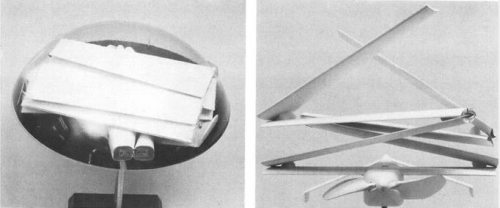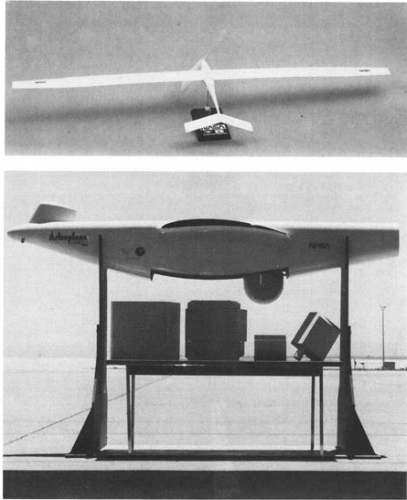You are using an out of date browser. It may not display this or other websites correctly.
You should upgrade or use an alternative browser.
You should upgrade or use an alternative browser.
NASA Mars Unmanned Aircraft
- Thread starter hesham
- Start date
- Joined
- 9 October 2009
- Messages
- 19,832
- Reaction score
- 10,320
From the link:
NASA Studies Mars Aircraft
Unmanned aircraft proposed as a candidate for a NASA follow-on mission could be carried in a protective aeroshell that would be mounted on an orbiter vehicle (above left). Once the orbiter reaches Mars, the aircraft would be released, and its wings, tail section and propeller deployed (above right). Basic configuration of the proposed aircraft is similar to a glider, and wingspan of the Mars aircraft is approximately 69ft. to provide lift in the Martian atmosphere (right). Weight of the wing is 70% of the aircraft's total structural weight. Powered by a hydrazine engine, the aircraft could carry scientific payloads of approximately 90-202 lb. over a distance of 6,200 mi. One version of the aircraft would have the capability to take off and land several times on the planet. Full scale mockup of the aircraft's forward fuselage was fitted with seven packages representing scientific instruments and with a deployable container to demonstrate the airplane's internal payload capacity (below right). Dome protruding from the rear of the payload bay is for an imaging system. Conceptual work on the aircraft was conducted by the California Institute of Technology's Jet Propulsion Laboratory and Developmental Sciences, Inc. Also contributing to the study were Martin Marietta Aerospace and Lear Seigler Astronautics. Some of the initial conceptual work on the Mars airplane was conducted by NASA's Dryden Flight Research Center in conjunction with the center's testing of the Mini-Sniffer remotely piloted vehicle (AW&ST Aug. 22, 1977, p. 18). A number of configurations have been studied during the evolution of the Mars airplane design, including a version with canards and one with a pusher-mounted engine. Advantages of the design include large tail area and stowability.
Aviation Week & Space Technology, March 5, 1979
- Joined
- 26 September 2008
- Messages
- 1,925
- Reaction score
- 625
That's a neat find. I think that there's color artwork that was produced back around that time showing it in flight over Mars. I remember seeing it in some books of space art.
NASA or NASA-funded researchers (JPL mainly) have looked at these kinds of things off and on for decades. There was even a Glenn Research Center proposal for a Discovery class mission using a Mars airplane. It would deploy in flight. There was an article in Air & Space Smithsonian about this a few years ago. There are several problems with these proposals, but mostly it boils down to risk--deploying the aircraft is risky (what if a wing sticks closed?) and the control system has to be totally foolproof. It is common for spacecraft to go into safe mode for various reasons, including radiation causing the computer to reboot. An autonomous airplane that goes into safe mode is going to crash, so it has to be designed to be totally fail tolerant. That's not easy to do.
NASA or NASA-funded researchers (JPL mainly) have looked at these kinds of things off and on for decades. There was even a Glenn Research Center proposal for a Discovery class mission using a Mars airplane. It would deploy in flight. There was an article in Air & Space Smithsonian about this a few years ago. There are several problems with these proposals, but mostly it boils down to risk--deploying the aircraft is risky (what if a wing sticks closed?) and the control system has to be totally foolproof. It is common for spacecraft to go into safe mode for various reasons, including radiation causing the computer to reboot. An autonomous airplane that goes into safe mode is going to crash, so it has to be designed to be totally fail tolerant. That's not easy to do.
- Joined
- 9 October 2009
- Messages
- 19,832
- Reaction score
- 10,320
From 1978, 'A concept study of a remotely piloted vehicle for Mars exploration', Final Technical Report, Developmental Sciences, Inc. (I included the CORE landing page just in case the direct link changes):
Candidate configurations are discussed for shuttle-transported, spacecraft-deployed remotely piloted vehicles having individual aeroshells, parachutes, and scientific payloads for Mars exploration. Topics covered include aerodynamics; powerplants; structural materials; deployment and descent interface systems; payloads; secondary power; thermal control; navigation, guidance and control, communications, weight and center of gravity; performance; and flight testing. The advantages of the recommended electric-powered cruiser/lander configuration are summarized
Hafidz Rahman
Just an Aeroweebs...
NTRS file, if the link isn't accessible:A concept study of a remotely piloted vehicle for Mars exploration', Final Technical Report, Developmental Sciences, Inc.


